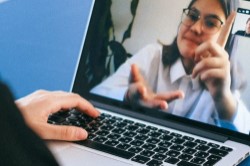 As people continue to work from home, video meetings are now the new normal. Whether the calls are one-on-one or in a group, people can expect to be part of many more video meetings over the next few months. To help with this transition, ILSPA have set out their guidelines to good video meeting etiquette.
As people continue to work from home, video meetings are now the new normal. Whether the calls are one-on-one or in a group, people can expect to be part of many more video meetings over the next few months. To help with this transition, ILSPA have set out their guidelines to good video meeting etiquette.
Preparation
As with any meetings you are participating in, preparation is key. However, along with having your notes and information ready, there are a few extra considerations when preparing for a video meeting. Make sure you set up your space for the call so that it looks professional. Try to find a tidy, private and quiet space to use. Make sure that your face is well lit but avoid being backlit, as this creates glare and makes your face hard to see. If you cannot find a suitable tidy space, you might want to consider using a background. Executive Secretary has a fantastic free professional background you can use.
Once you have chosen your location, set up your computer and test your microphone and camera to make sure they are working correctly. When testing your camera, take the time to check that it is positioned properly. Ideally, you want it to appear that you are looking straight forward at the screen, rather than looking down or upwards. You may find moving the screen farther away, adjusting the angle of the screen or even raising the computer on some books will help with this. Also, make sure that the computer has a good internet connection and is fully charged. If not, make sure you can plug it in nearby.
Get all your notes and information ready as you would in a normal meeting. If you are likely to need to share your screen, take a moment to clear your desktop. Close any unneeded tabs and hide any sensitive or private information.
Appearance
A perk of working from home is that you don’t necessarily need to worry about your appearance. However, when attending a video meeting you need to treat it as you would any other in-person meeting. So, dress and present yourself as you would normally.
Make sure to think about your posture and position when you are on screen. You are more visible in a video meeting, as unlike in a normal meeting you are in front of the whole team for the entire duration.
During the call
Once the call has begun, it is advisable to mute yourself if you are not the one talking, to avoid your microphone picking up background noise. Equally, it can be a good idea to turn off your camera temporarily if you need to move away or if something unexpected happens, to avoid this being distracting for the other participants.
If you are going to have regular meetings within your company, you may wish to establish a signal for when you want to speak. This avoids unexpected interruptions throughout the call. Some video conference software includes buttons that you can click to signal that you wish to speak or ask a question. If you are leading the call, make sure to introduce people or reply to people by name so that everyone is aware who is speaking.
When it is your turn to talk, speak clearly and at your normal volume. You may want to pause for a few seconds before you start to speak in case there is a sound delay. Look into the camera when you talk to make eye contact. Try not to look at yourself or other participants as it may look like you are distracted by something else. If there’s a pause in the conversation because, for instance, you need to pull up an email or reference a document, make sure to communicate that. Delays or long stretches of silence might make it seem like you’ve lost connection.
Stay focused throughout the meeting. Tempting as it may be, try not to work or answer messages while on the call as you may miss something important. Definitely do not play on your phone or eat. Remember, you are always visible.
Note- and minute-taking
If you (as many Legal Secretaries and PAs will be) are responsible for taking the minutes of the meeting, treat it like any other meeting and take your notes the same way. Just remember that most video conference software includes the option to record. As long as you have permission, utilise this and record the meetings to go back to when you write up the minutes.
Another great feature of a video meeting is that you have a list of the participants available for you. Make a note of them all as they join/introduce themselves before the meeting starts if you can. This will make it a lot easier to know who is speaking during the call.
If you would like some further guidance on note-taking, please read ILSPA’s Useful Tips for Effective Note Taking in our journal archive.

